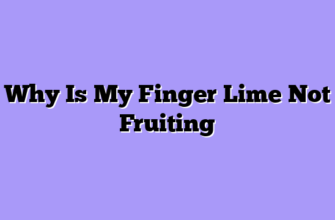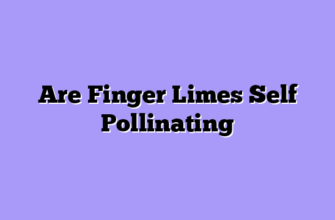I’ve been growing exotic citrus for over fifteen years now, and let me tell you, nothing breaks a farmer’s heart quite like watching those beautiful finger lime leaves turn from vibrant green to sickly yellow. You know what I’m talking about – those precious Australian finger limes, also called citrus caviar or lime caviar, that we’ve all come to love for their burst of tangy pearls.
Just last month, I walked through my grove and noticed several of my prized finger lime trees showing signs of chlorosis – that’s the fancy term we use for yellowing leaves. After two decades of wrestling with these finicky beauties, I’ve learned that yellow leaves aren’t just cosmetic issues. They’re your tree’s cry for help, and understanding what’s causing this distress can mean the difference between a thriving harvest and a disappointing season.
Understanding the Finger Lime: More Than Just a Pretty Fruit
Before we dive into the yellow leaf problem, let’s talk about what makes these trees so special – and so challenging. Finger limes (Citrus australasica) aren’t your typical backyard citrus. These native Australian beauties have been dubbed “citrus caviar” for good reason. When you bite into one, those little vesicles pop in your mouth like tiny flavor bombs.

These trees are naturally understory plants in Australian rainforests, which means they’re adapted to dappled light and consistent moisture – conditions that are tricky to replicate in most American growing zones. They’re slow growers, often taking 3-5 years to produce their first meaningful harvest, and they’re notoriously sensitive to environmental changes.
The Main Culprits Behind Yellow Leaves
Nutrient Deficiencies: The Silent Killers
In my experience, nutrient deficiencies account for about 60% of yellowing issues in finger lime trees. These plants are heavy feeders, particularly when it comes to nitrogen, iron, and magnesium. I learned this the hard way during my third year of cultivation when nearly half my grove started showing symptoms.
Nitrogen deficiency typically shows up as overall yellowing, starting with older leaves at the bottom of the tree. It’s like the plant is cannibalizing itself, pulling nutrients from older growth to support new development. Iron deficiency, on the other hand, causes what we call “interveinal chlorosis” – the leaves turn yellow while the veins remain green, creating a distinctive striped pattern.
Magnesium deficiency is particularly sneaky. It starts with yellowing between the leaf veins on older leaves, but unlike iron deficiency, it progresses from the leaf margins inward. I’ve seen entire sections of my grove affected when the soil pH shifted too far from the optimal 6.0-7.0 range, making magnesium unavailable even when it’s present in the soil.
Water Stress: Too Much or Too Little
Here’s where finger limes really show their finicky nature. These trees need consistent moisture but absolutely despise waterlogged conditions. I call it the “Goldilocks syndrome” – everything has to be just right.
Overwatering is actually more common than drought stress in my experience. When roots sit in soggy soil, they can’t absorb nutrients properly, leading to what looks like nutrient deficiency but is actually a water management issue. I’ve seen this happen repeatedly with new growers who treat finger limes like thirsty tropical plants.
Underwatering presents differently. The leaves don’t just turn yellow – they become crispy and brown at the edges before dropping. During California’s drought years from 2012-2016, I had to completely revamp my irrigation system to keep these sensitive trees happy.
Pest Problems: The Uninvited Guests
Citrus leaf miners are the bane of my existence. These tiny larvae tunnel through leaves, creating silvery trails that weaken the plant and make it susceptible to other issues. The damaged leaves often turn yellow and drop prematurely. Asian citrus psyllids are another major concern – not just for the direct damage they cause, but because they can spread huanglongbing (HLB), a devastating bacterial disease.
Scale insects are particularly problematic on finger limes because they’re often overlooked until the infestation is severe. These tiny, dome-shaped pests attach to stems and leaves, sucking plant juices and secreting honeydew that attracts sooty mold. The result? Yellowing, weakened foliage that eventually drops.
| Problem | Symptoms | Most Common Cause | Quick Fix |
|---|---|---|---|
| Overall yellowing from bottom up | Older leaves turn yellow first, then drop | Nitrogen deficiency | Apply balanced citrus fertilizer |
| Yellow with green veins | Striped appearance on new growth | Iron deficiency | Apply chelated iron supplement |
| Yellow between veins, older leaves | Progresses from margins inward | Magnesium deficiency | Epsom salt application |
| Yellowing with wilting | Leaves feel soggy or mushy | Overwatering | Improve drainage, reduce watering |
| Yellow with brown crispy edges | Leaves drop quickly | Underwatering | Increase irrigation frequency |
| Silvery trails with yellowing | Curled, distorted leaves | Citrus leaf miner | Systemic insecticide treatment |
Environmental Factors: When Mother Nature Doesn’t Cooperate
Temperature stress is a huge factor that many growers underestimate. Finger limes prefer temperatures between 55-85°F, and they really don’t appreciate sudden changes. I learned this during an unexpected cold snap in 2018 when temperatures dropped to 28°F overnight. The next morning, I found yellow leaves scattered across the ground like fallen autumn foliage.
Wind damage is another often-overlooked cause of yellowing. These trees have relatively brittle branches, and strong winds can cause microscopic damage that shows up as yellowing days later. After installing windbreaks around my more exposed plantings, I saw a significant reduction in leaf yellowing during our windy spring months.
Soil Issues: The Foundation of Healthy Growth
Soil pH problems are incredibly common with finger limes. These trees prefer slightly acidic to neutral soil (pH 6.0-7.0), but many areas have naturally alkaline soils that lock up essential nutrients. I test my soil pH quarterly and adjust with sulfur or lime as needed.

Disease Considerations: The Serious Threats
Huanglongbing (HLB), also known as citrus greening disease, is every citrus grower’s nightmare. The symptoms include yellowing leaves, but it’s accompanied by asymmetrical leaf patterns and bitter, misshapen fruit. There’s no cure, and infected trees must be removed to prevent spread. I inspect my trees monthly for early signs and maintain strict sanitation protocols.
Phytophthora root rot is another serious concern, especially in areas with poor drainage. This soil-borne fungus attacks the root system, causing yellowing that starts at the top of the tree and works its way down – the opposite of nutrient deficiency patterns. Prevention through proper drainage is key, as treatment options are limited once infection occurs.
My Step-by-Step Diagnostic Approach
When I encounter yellowing leaves, I follow a systematic approach that’s served me well over the years. First, I examine the pattern of yellowing. Is it starting from the bottom and working up? That suggests nitrogen deficiency. Starting from the top? Could be root problems or disease. Scattered throughout the canopy? Probably environmental stress or pests.
Next, I check the soil moisture by digging down about 4 inches near the root zone. The soil should be moist but not soggy – think of a wrung-out sponge. I also examine the roots if possible, looking for signs of rot or damage.
Then comes the pest inspection. I look under leaves for insects, check bark for scale or other pests, and examine stems for signs of damage. Don’t forget to check for citrus leaf miner trails – they can be subtle but are often the culprit behind mysterious yellowing.
Treatment Strategies That Actually Work
For nutrient deficiencies, I use a combination approach. A high-quality citrus fertilizer applied according to package directions handles most macro-nutrient needs. For specific deficiencies, I use targeted treatments: chelated iron for iron chlorosis, Epsom salt (magnesium sulfate) for magnesium deficiency, and supplemental nitrogen during the growing season.
Water management improvements often require infrastructure changes. I’ve installed drip irrigation systems with timers to maintain consistent moisture levels. In poorly draining areas, I’ve built raised beds or added drainage tiles. For container-grown trees, I ensure pots have adequate drainage holes and use well-draining potting mix.
Pest management is an ongoing battle. I use beneficial insects whenever possible – ladybugs for aphids, predatory mites for spider mites. For severe infestations, I apply horticultural oils or insecticidal soaps, always following label directions carefully. Systemic insecticides are my last resort, used only when necessary and never during bloom periods that might affect pollinators.
Prevention: The Best Medicine
After years of troubleshooting yellow leaf problems, I’ve learned that prevention is far easier than treatment. I maintain a regular fertilization schedule, typically feeding my finger limes every 6-8 weeks during the growing season with a balanced citrus fertilizer supplemented with micronutrients.
Mulching has been a game-changer for my operation. A 3-4 inch layer of organic mulch around each tree helps maintain soil moisture, suppresses weeds, and slowly releases nutrients as it decomposes. I use a mix of wood chips and aged compost, keeping the mulch a few inches away from the trunk to prevent pest and disease issues.
Regular monitoring is crucial. I walk through my grove weekly during the growing season, looking for early signs of problems. It’s much easier to address yellowing when it first appears than to wait until the problem becomes severe.
When to Call in the Professionals
Sometimes, despite our best efforts, professional help is needed. If yellowing persists despite addressing obvious causes, or if you suspect disease issues like HLB, don’t hesitate to contact your local agricultural extension office or a certified arborist with citrus experience.
I’ve learned to swallow my pride and ask for help when needed. During my early years, stubbornness cost me several trees that might have been saved with professional intervention. Now, I maintain relationships with plant pathologists and entomologists who can provide expert diagnosis when problems exceed my expertise.
The Bottom Line
Growing finger limes successfully requires patience, attention to detail, and a willingness to learn from mistakes. Yellow leaves are often the first sign that something isn’t quite right, but they’re also an opportunity to improve your growing practices and better understand these fascinating plants.
Remember, finger limes are worth the effort. When you bite into that first homegrown fruit and feel those caviar-like vesicles burst with intense citrus flavor, you’ll understand why we put up with all the challenges. The key is learning to read what your trees are telling you and responding quickly to their needs.
Keep detailed records of what works and what doesn’t in your specific growing conditions. Every location is different, and what works in my California grove might need adjustment for your climate and soil conditions. Stay curious, stay observant, and don’t be afraid to experiment with new approaches when the old ones aren’t working.
Most importantly, enjoy the journey. Growing exotic fruits like finger limes connects us to the natural world in a unique way and provides flavors that simply can’t be replicated by store-bought alternatives. Those yellow leaves might be frustrating in the moment, but they’re also part of the learning process that makes us better growers and more appreciative of the incredible plants we’re privileged to cultivate.








